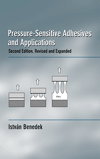Pressure-Sensitive Adhesives and Applications
Product Details
Features
- Provides broad coverage of the relationship between the science, manufacture, and application of Pressure Sensitive Adhesives (PSA)
- Covers how chemical composition help determine practical formulation and manufacturing of PSA
- Addresses polymer rheology, chemistry, and processing as it relates to PSAs
- Discusses raw materials, formulation, manufacturing, coating, and characterization of PSAs
-
Examines coating and converting equipment for PSAs, accounting for environmental requirements
Summary
Pressure-Sensitive Adhesives and Applications, Second Edition explains how pressure-sensitive adhesives (PSAs) work, why they are used, and the technology used to manufacture them. This second edition features the latest developments in the field.
Dr. Benedek discusses the factors that affect the rheology and special flow characteristics responsible for the adhesivity of liquid and solid PSAs. His book explores the viscoelastic behavior of PSAs, and compares them to plastics, rubbers, and polymers properties and examines the parameters that influence the conversion process of PSAs from the coating of carrier materials to the properties of the final laminate. The author covers adhesion/cohesion balance, time-temperature dependence of pressure sensitivity, chemical composition, coating properties, and coating processes affect the adhesive properties of PSA and their end products and how application-specific performance indices are used to determine the formulation and manufacture of raw materials. In addition, up-to-date coating machines, converting technology, and environmental considerations in the manufacture of PSA final products as well as industry-specific methods of testing for quality assurance and control are discussed.
Pressure-Sensitive Adhesives and Applications, Second Edition combines the theoretical basis of pressure sensitivity with the practical aspects of manufacturing, testing, and use of PSAs. Readers are offered an exhaustive as well as comparative look at the engineering of plastics, adhesives, and pressure-sensitives, resulting in an indispensable, up-to-date reference for adhesive and polymer chemists and technologists.
